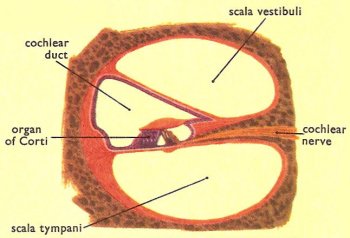cochlea

Cutaway illustration of the cochlea.

Cross-section of one spiral of the cochlea.
The cochlea is the part of the inner ear which contains the organ concerned with the reception of sound and the analysis of pitch – the so-called organ of Corti. It is found in humans and other mammals, birds, and some reptiles (such as crocodiles). The cochlea arises as a projection of the sacculus and in the mammalian ear is snail-shaped (hence its name).
Structure of the cochlea
The central axis of the cochlea is called the modiolus. From this structure a delicate bony shelf, called the osseus spiral lamina, projects into the canal of the cochlea and continues throughout its length. Fibers of the cochlear nerve, or auditory nerve, run from the modiolus through the center of the lamina.
Attached to the osseus spiral lamina of the cochlea are two delicate membranes. The lower of these, the basilar membrane, stretches from the free edge of the lamina to the outer wall of the cochlear canal. The upper membrane, the vestibular membrane, springs from the lamina a little nearer the modiolus and is attached to the wall of the cochlear canal a little above the basilar membrane. In this way the cochlear canal is divided into three: the scala vestibuli above, the cochlear duct in the middle, and the scala tympani below. The cavities of the scalae vestibuli and tympani are connected at the top of the cochlea by a minute hole called the helicotrema. The cochlear duct is part of the membranous labyrinth (see bony labyrinth for more details).
The organ of Corti, within the cochlea, is lined with sensitive cells that have tiny hairs. The cochlear canal is filled with fluid (endolymph) and surrounded by fluid (perilymph). Vibrations of the oval window, induced by sound, are transmitted through the perilymph and endolymph and stimulate the hair cells of the organ of Corti. These in turn stimulate nerve cells that transmit information, via the auditory nerve, to the brain.


